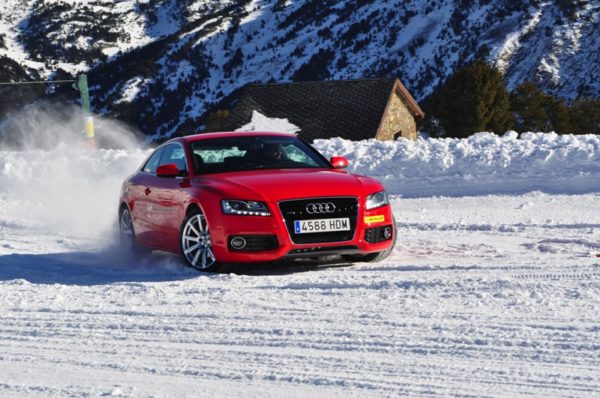Blog
How Does Audi Quattro Work?

You just picked up an Audi with quattro and you might be asking yourself what is Audi quattro and how does Audi quattro work? Well you are in luck! We are going to go over not just what quattro is, but also the different type of systems that Audi has used over the years.
What is Audi quattro?
Audi quattro is the name that Audi gives its all-wheel drive system. Ironically enough, Audi is using the Italian word for “four” to describe its German engineering feat. I am going to chalk that up to some smart marketing guys that realized the number four in German is vier; which is pronounced “feer”. Something akin to fear in English is probably not a good name to give one of your proudest safety features.
How does Audi quattro work?
Quattro works by adjusting power to the wheels that have the most traction providing the driver with the best vehicle grip instead of providing that power to tires that are slipping.
Types of Audi quattro
There are a couple different types of quattro systems that Audi has used over the years depending on model and engine layout.
Locking Center Differential
In the original quattro system the torque was sent through the transmission to a manual locking mechanical center differential which distributes the torque between the front and rear axles.
Torsen Center Differential
Audi replaced a manually locking center differential with the Torsen (torque sensing) center differential. This allowed engine torque to be automatically directed to individual axles as driving conditions, and grip warranted. Under normal conditions (where grip in both front and rear axles is equal), torque is split between front and rear with a default 50:50 distribution in many, though not all, versions. In adverse conditions a maximum of 67-80% (depending on the transmission, or model of Torsen differential) of the engine’s torque can be directed to the front or rear axles. The fully automated mechanical nature of the Torsen center differential helps prevent wheel slippage from occurring, by diverting torque instantly to the axle which has more grip. This method of operation can be described as proactive. Unlike the various types of electronically operated differentials, Torsen has no requirement for electronic data, from sources such as wheel speed sensors; therefore, it has an element of “fail-safe”, unlike designs such as Haldex, should one of the wheel speed sensors develop a fault. In comparison, viscous coupling and electronically controlled center differentials that are used in other four-wheel drive systems are reactive, since they only redirect torque after wheel slippage has occurred. The advantage is felt under hard acceleration, including while cornering, since the torque transfer between axles is seamless, thus maintaining stable vehicle dynamics, and considerably reducing the chance of losing control of the vehicle.
The Torsen-based quattro system also offers an advantage, in the opposite function of distributing torque to the road wheels, namely engine braking. When engine braking is used to slow the car down, with Torsen-based systems, the resulting reverse-torque loads on the front and rear axle are equally stabilized, in exactly the same way that engine propulsion torque is apportioned fully mechanically autonomously. This allows the spreading of the engine braking effect to all four wheels and tires. The Torsen-based quattro-equipped vehicle is able to execute a more stable high-speed turn under deceleration, with less risk of losing control due to loss of grip in the front or rear axles.
There are a few drawbacks of the Torsen quattro system.
- Placement of the axle behind the engine leads to the car being more nose-heavy
- The amount of torque able to be allocated to a slipping axle is mechanically limited by the differential; so, in some cases the axle with the least amount of traction will not receive all of the torque that it needs. There have been some advancements to address this with electronic differential locks and the newer type “C” that utilizes a planetary gear to adjust the torque bias.
Viscous Coupling
Instead of using a center differential a viscous coupling is used to redirect up to 50% of the torque to the axle losing traction. A viscous coupling is a mechanical device which transfers torque and rotation by the use of a viscous fluid =. Typically about 5% torque is pretensioned on the coupling to increase the speed of torque transfer. When slipping occurs the coupling locks and redirects the torque to the slipping axle.
The big disadvantage of this system is the delay of the viscous coupling locking. This can cause sudden changes from understeer to oversteer while accelerating on slippery surfaces resulting in unpredictable vehicle behavior for the driver. It can also cause the vehicle to dig into sand and deep snow before activating the all-wheel drive causing a higher probability of getting stuck
Haldex
The Haldex system takes a front-wheel drive platform and converts this to all-wheel drive through the use of electronic sensors and differentials to redirect power to the rear wheels. Haldex equipped vehicles normally run in front-wheel drive mode, but when the computer senses that there is a loss of traction torque will redirect torque to the rear wheels (even up to 100%) to compensate for the loss of traction at the front.
The benefits of Haldex is the reduction of manufacturing and development costs as it can be adapted to FWD vehicles. It also has fuel efficiency benefits as the vehicle under most driving conditions is only driving the front wheels.
The drawback of Haldex is that it is primarily front-wheel drive, under heavy loads, Haldex equipped vehicles have a tendency to understeer massively, as the computers are often too slow to apportion torque to the rear axle, and as the default torque distribution remains front-wheel orientated.
Audi quattro is legendary for a reason and hopefully this help you gain some understanding on the different types of systems that Audi has used over the years.
Should you ever have need of maintenance or repair on your Audi quattro system give us a call at Alex’s Autohaus and we would love to help you out. Call (801) 566-6115 or follow this link to schedule.

Nationwide Warranty
3 YEAR, 36,000 MILE
Alex’s Autohaus offers all customers the Bosch and Tech-Net Peace of Mind Nationwide Warranty. The 36 month/36,000 mile warranty is honored at over 10,000 service centers across the country. Our 36,000 mile warranty is the best in the business!
Read More Schedule Now